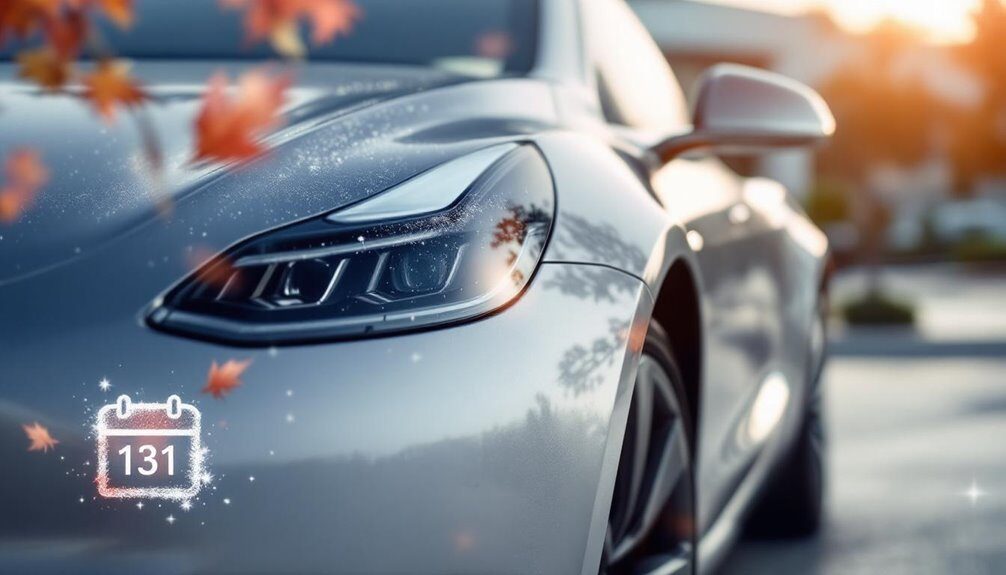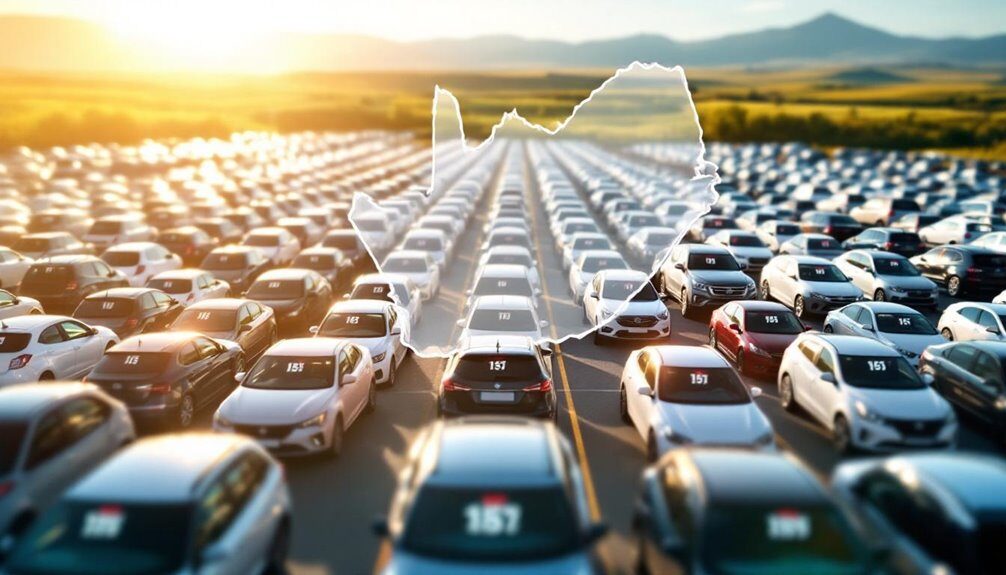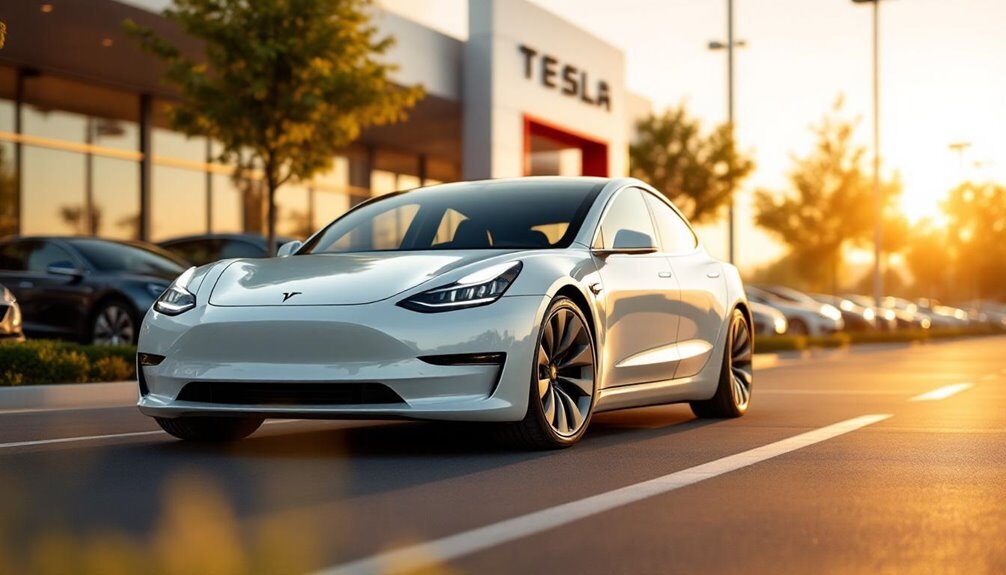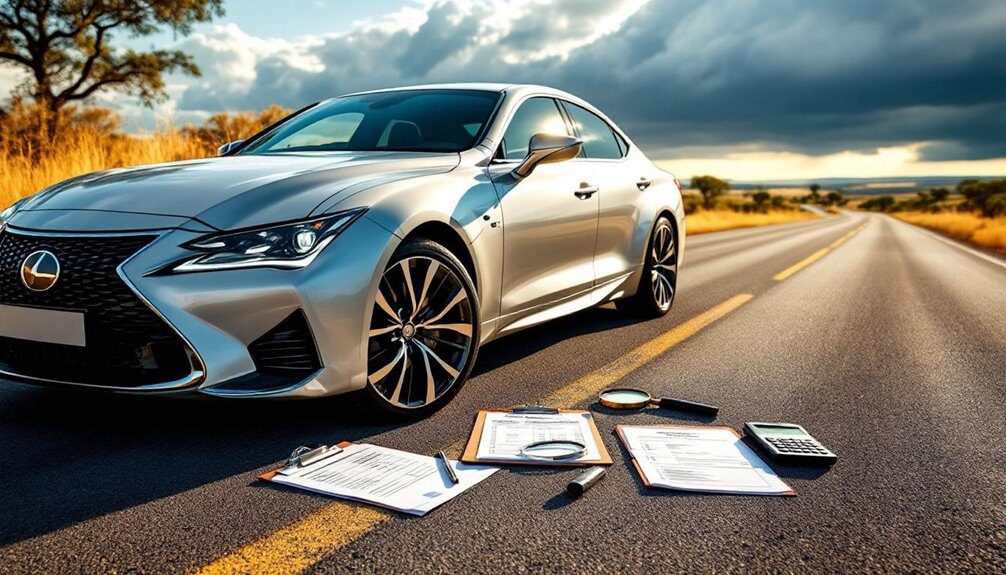You’re hunting for 20,000–25,000 km yearly—that’s South Africa’s sweet spot. A one-year-old car should sit around 15,000–20,000 km; anything higher and resale value takes a hit. High-mileage territory starts at 150,000–200,000 km, though consistent maintenance records matter more than raw numbers. Skip the garage queen with mysteriously low mileage. What really counts? Service history. A well-documented 150,000 km beats an undocumented 80,000 km every time. The specifics get thorniest from here.
Understanding Average Annual Mileage in South Africa
When you’re hunting for a used car in South Africa, mileage’s probably the first thing you’ll obsess over—and honestly, you should. Here’s the baseline: South Africa’s average annual mileage sits around 33,333 km. Most regular vehicles clock about 25,000 km yearly. Exceed that? You’re looking at roughly 10% depreciation.
Now, it gets weird fast. A 1.6-litre petrol might average just 16,000 km annually, whilst diesel models cruise towards 24,000 km. The real kicker: once you hit 150,000–200,000 km, you’re officially in high-mileage territory. Anything past 300,000 km demands serious know-how or justification. Regular maintenance performed, such as oil changes and tyre rotations, can extend the usable life of high-mileage vehicles significantly. Keeping your vehicle in peak condition through scheduled service plans ensures that even higher-mileage cars remain reliable and efficient. For business use, it’s worth noting that the tax-free rate per kilometre is 476 cents per km as of March 2025, which may affect the value proposition of higher-mileage vehicles used for commercial purposes. Many dealerships across South Africa, such as those offering nationwide delivery, provide quality used vehicles with varied mileage options to suit different budgets and requirements.
Your driving style—urban versus rural—shapes these numbers dramatically too.
Ideal Mileage Benchmarks by Vehicle Age
A 1-year-old? You’re looking at 15,000–20,000 km. Anything below that screams underuse. Above? Red flag.
For a 1-year-old car, 15,000–20,000 km is the sweet spot. Anything less signals underuse; anything more raises concerns.
Two years in, expect 30,000–40,000 km. Three years? Push that to 45,000–60,000 km. By year four, 60,000–80,000 km is normal. Year five sits at 75,000–100,000 km.
Here’s the thing: low-mileage cars *look* tempting. They’re not always winners. In July 2025, the average mileage recorded was 73,579 km, showing that moderately-used vehicles remain the market standard.
Those underused vehicles? Check their service history hard. Storage takes its toll. Sometimes a car that’s actually driven gets better maintenance than one gathering dust in a garage. At Autobahn Motors, our experienced team can help evaluate the condition of underused vehicles to ensure you’re making a confident purchase.
Know the range. Stay sharp.
How Mileage Affects Resale Value
Mileage is basically the grim reaper of resale value. Here’s the brutal truth: every kilometre you rack up chips away at what you’ll get back when you sell.
| Vehicle Age | Mileage Impact |
|---|---|
| First year | Steepest depreciation per km |
| 3–5 years | Above-average mileage loses 30–40% |
| 5+ years | High mileage compounds losses severely |
| Consistently low | Better retention across all ages |
Buyers want low-mileage cars. You want buyers. Simple equation. Popular models like the Hilux or Corolla with modest mileage? They’re gold. Luxury vehicles with high mileage? Forget it—they tank faster than you’d think. Rising fuel costs mean fuel-efficient, low-mileage vehicles aren’t just preferred anymore. They’re practically mandatory in buyers’ searches. Low mileage signals reliability. It means fewer repairs ahead, which is why maintaining your vehicle with quality replacement parts becomes essential to preserve that value. If you’re looking to purchase a used vehicle, consulting with a trusted dealer offering comprehensive automotive care can help you find a well-maintained option that retains its value. Fewer headaches. That’s what people actually pay premium prices for in today’s market.
Maintenance Costs and High-Mileage Vehicles
For vehicles valued under R200,000, you’re spending roughly 47 to 59 pence per kilometre just on upkeep. Yeah, that adds up fast. High-mileage cars? They’ll drain your wallet harder. We’re talking engine failures hitting R83,250 to R129,500. Transmission problems. Suspension work around R46,000. It’s unrelenting.
High-mileage vehicles drain wallets fast—engine failures alone cost R83,250 to R129,500. Maintenance is relentless.
The wear compounds. Every kilometre punishes critical components—engines, gearboxes, suspension systems. Parts replacement frequency skyrockets with accumulated distance. Brake pads, tyres, fluids. The surprises never stop either. Windscreen cracks. Unexpected repairs. You can’t budget for chaos, but you should try. Regular brake maintenance ensures critical safety systems remain reliable as your vehicle ages.
Vehicle type matters too. That entry-level saloon? Cheaper to fix. An older SUV? Suspension and transmission failures become inevitable, expensive nightmares as mileage climbs.
To protect your investment and minimise these escalating costs, experienced technicians can provide proper diagnostics and maintenance to catch problems before they become catastrophic failures.
High mileage isn’t just a number on the odometer. It’s a financial forecast nobody wants.
Reliability Indicators Beyond Just Mileage
You probably think mileage tells you everything—it doesn’t. Service history and maintenance records are what actually separate the genuinely reliable cars from the ticking time bombs, and you’d be shocked how many sellers conveniently “lose” their paperwork right when you ask.
Consistency matters far more than raw numbers; a 200,000 km vehicle with documented services every 10,000 km will outrun a suspiciously low-mileage mystery car that skipped half its scheduled maintenance.
Regular upkeep through routine maintenance services prevents major issues and extends vehicle lifespan, making it essential to verify that a used car has received proper care throughout its ownership history. Professional tyre inspections and rotations are critical components of this maintenance that many owners overlook, yet they directly impact both safety and longevity.
Service History Importance
Accident repairs, mechanical faults, flood damage—the stuff sellers conveniently forget to mention. That’s where service history saves you. Here’s what you’re actually getting:
- Fraud detection: Documented maintenance intervals catch odometer tampering. Records don’t lie like dashboards do.
- Wear patterns revealed: You’ll spot chronic problems early. Frequent repairs? Red flag. The history shows how hard that car was really driven.
- Reliability prediction: Vehicles with full servicing schedules break down 25-30% less than those without records. That’s not opinion—that’s data.
Service records expose hidden issues external inspections miss. They prove whether someone actually maintained their motor or just drove it into the ground. In South Africa’s used car market, that documented history is your armour against the scams.
Maintenance Records Matter
Mileage tells you one thing. Maintenance records? They tell you *everything*. You’re looking at a vehicle with 120,000 km—brilliant. But if there’s no service history backing it up, you’re basically playing automotive roulette.
Here’s the deal: fleet-maintained vehicles from rental companies typically show consistent service records. That matters. It means someone actually cared about the car’s health. Private owners? Hit or miss.
You want organised sector quality assurance working in your favour. Rigorous maintenance schedules reveal how hard—or how easy—a vehicle’s been treated. Regular servicing catches problems before they become catastrophes.
Don’t get seduced by low mileage alone. A well-documented 150,000 km vehicle beats a mystery 80,000 km car every single time. Records don’t lie. Everything else does.
Consistency Over Raw Numbers
a car driven 15,000 km yearly is way more reliable than one that sat unused for months then got hammered. Consistency signals proper maintenance and steady use. Sporadic driving? That’s when batteries die, fluids degrade, and problems sneak up on you.
Check these patterns:
- Regular service intervals (every 10,000–15,000 km) trump total mileage—they’re proof someone actually cared
- Steady annual usage (15,000–25,000 km per year) beats erratic patterns that leave vehicles vulnerable
- Documented, predictable history shows you a car that’s been genuinely driven, not neglected
High-mileage vehicles with excellent condition? Those outsell pristine garage queens that’ve been dormant. Real-world reliability lives in the pattern, not the number.
Current Market Trends for 2026
As South Africa’s used car market barrels into 2026, the momentum’s undeniable. Sales jumped 16.4% year-on-year in September 2025—people are buying. The cumulative value hit R16.11 billion in October alone. That’s real money moving.
Here’s what’s shifting: you’re seeing lower mileage vehicles become the norm. Average mileage dropped to 72,726km in October 2025. Buyers want newer cars without the new car price tag. It’s not rocket science—economic pressure’s real. Unemployment’s crushing household budgets. New cars cost over R450,000. Used vehicles? They’re the only option that makes sense financially.
Compact hatchbacks and crossovers dominate now. The Ford Ranger, Toyota Hilux, and Volkswagen Polo Vivo stay on top. Luxury saloons? Dead on arrival.
The course is clear: affordable, economical, lower-mileage vehicles will own 2026.
Making Your Used Car Purchase Decision
When you’re staring down a used car listing, mileage and price tell completely different stories—one car might’ve been babied at 80,000 km whilst another’s been hammered at 120,000 km, yet they’re priced the same.
Your real move? Check the service history records, because that paperwork either confirms the seller actually maintained the thing or exposes they’ve been coasting on fumes and prayers.
Mileage alone won’t save you; it’s the maintenance trail that separates a solid buy from a ticking time bomb.
Assessing Mileage Against Price
One number makes or breaks your used car deal: mileage. You’re looking at a market where buyers pay serious money for lower-mileage vehicles. Here’s what separates smart shoppers from the rest:
- Entry-level cars (under R200,000) depreciate 15–20% yearly, with mileage as the main culprit
- Mid-range vehicles (R200,000–R400,000) drop faster if they’ve hit above 20,000km annually
- High-end models (R400,000+) bleed value hard—each extra 10,000km costs you 8–12%
South African drivers typically clock 20,000–25,000km yearly. Anything below 15,000km? That’s premium territory.
Popular models like the Ford Ranger hold their value despite higher mileage, but most vehicles don’t get that courtesy. Compare mileage against annual usage benchmarks before you commit your cash.
Evaluating Service History Records
Documentation. Here’s the thing: service records aren’t just paperwork. They’re proof your car’s been looked after—or neglected. You’re looking at dates, odometer readings, specific work done. The whole story, basically.
| What to Check | Why It Matters |
|---|---|
| Service centre details | Proves legitimate maintenance |
| Exact dates & mileage | Catches suspicious gaps |
| Specific work performed | Shows preventative care |
| Major repairs documented | Reveals past problems |
Missing records? Red flag. Incomplete history means hidden issues lurking. You can’t just trust someone’s word. Cross-check invoices against the service log. Contact previous owners if needed. Modern vehicles have dashboard computers—use that data.
Yeah, it’s tedious. But vehicles with full service histories hold their value better and cost you less in surprise repairs down the road. Skip this step, and you’re basically gambling.




